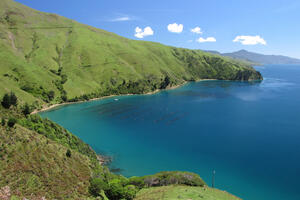
Photo Credit: Ben – CC BY-ND 2.0
Cook named many places after men in the Admiralty because they were the power (and the money) behind his voyages. The Admiralty is the government department that controls the British navy. Its responsibilities have varied over the centuries, but in the later eighteenth century it oversaw government-sponsored voyages of exploration, as well as its usual military role. Therefore, when the Royal Society wanted to send scientists to Tahiti for astronomical observations and explore the possibility of a southern continent, they approached the Admiralty. The Admiralty, seeing a chance for imperial as well as scientific gain, organised the voyage, eventually with Cook as its lead.
Cook liberally sprinkled the names of the men responsible for this voyage, clearly with the hopes of securing another. In addition to the two secretaries, Cook named five other locations after Admiralty members:
- Cape Brett for Rear-Admiral Sir Piercy Brett, a lord commissioner of the Admiralty.
- Cape Colville for Alexander Colville. Cook had served under Colville on the HMS Northumberland in Canada and Colville recognised Cook’s skills in surveying, ordering him to survey the coastline of Newfoundland.
- Hawke Bay for Edward Hawke (1705-1781), first lord of the Admiralty, 1766-1771, who had inadvertently helped appoint Cook to lead the voyage, after rejecting civilian Alexander Dalrymple.
- Cape Palliser for Sir Hugh Palliser (1723-1796), governor and commander-in-chief of Newfoundland while Cook was carrying out his survey there and later comptroller of the navy.
- Mount and Cape Egmont for John Perceval (Earl of Egmont). Perceval had little direct connection with Cook’s voyage, but had been First Lord of the Admiralty from 1763 to 1766.
Although Cook named the area between Capes Stephens and Jackson, today Admiralty Bay only covers the much smaller area between Rangitoto ki te Tonga / D’Urville Island and the peninsula that ends at Clay Point.
References
- NZ Gazetteer - Admiralty Bay
- James Cook, ’31 March 1770’, South Seas: Voyaging and Cross-Cultural Encounters in the Pacific (1760-1800)
- J. K. Laughton, revised by Roger Morriss, ‘Brett, Sir Peircy (1709–1781)’, Oxford Dictionary of National Biography, 3 September 2004
- Ruddock Mackay, ‘Colvill, Alexander, seventh Lord Colville of Culross’, Oxford Dictionary of National Biography, 3 January 2008
- ‘April-June 1768’, Captain Cook Society
- J. K. Laughton (revised by Roger Morriss), ‘Palliser, Sir Hugh, first baronet (1723–1796)’, Oxford Dictionary of National Biography
- ‘Report of the NZ Geographic Board to the Minister of Lands under Section 13…’, p. 11